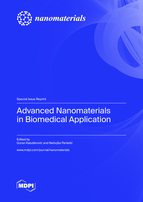Advanced Nanomaterials in Biomedical Application
A special issue of Nanomaterials (ISSN 2079-4991). This special issue belongs to the section "Biology and Medicines".
Deadline for manuscript submissions: closed (20 January 2023) | Viewed by 39690
Special Issue Editors
Interests: antitumor drugs; molecular oncology; drug targeting; medicinal chemistry
Special Issues, Collections and Topics in MDPI journals
Interests: inorganic chemistry; bioinorganic chemistry; nanomaterials; metal-based complexes; anticancer drugs
Special Issues, Collections and Topics in MDPI journals
Special Issue Information
Dear Colleagues,
In the last few decades, many efforts have been focused on the discovery of various types of nanomaterials. The goal for such research, in addition to basic research on the synthesis of nanoconstructs, has been to identify nanoparticles applicable in different fields, for instance, in technological (catalysis), medical applications (drug delivery), and others. Thus, because of the growing possibility of purposes, the need for novel nanomaterials is growing fast.
This Special Issue on “Advanced Nanomaterials in Biomedical Application” aims to showcase the most recent advances of nanomaterials not only in synthesis and characterization, but also their technological application. This Special Issue welcomes original research articles and reviews. Research areas may include all types of nanomaterials used in the development of medical applications (e.g., therapeutic: anticancer, antibacterial, toxicology; diagnostic: imaging; nanodevices, and others).
We look forward to receiving your contributions.
Prof. Dr. Goran Kaluđerović
Prof. Dr. Nebojša Pantelić
Guest Editors
Manuscript Submission Information
Manuscripts should be submitted online at www.mdpi.com by registering and logging in to this website. Once you are registered, click here to go to the submission form. Manuscripts can be submitted until the deadline. All submissions that pass pre-check are peer-reviewed. Accepted papers will be published continuously in the journal (as soon as accepted) and will be listed together on the special issue website. Research articles, review articles as well as short communications are invited. For planned papers, a title and short abstract (about 100 words) can be sent to the Editorial Office for announcement on this website.
Submitted manuscripts should not have been published previously, nor be under consideration for publication elsewhere (except conference proceedings papers). All manuscripts are thoroughly refereed through a single-blind peer-review process. A guide for authors and other relevant information for submission of manuscripts is available on the Instructions for Authors page. Nanomaterials is an international peer-reviewed open access semimonthly journal published by MDPI.
Please visit the Instructions for Authors page before submitting a manuscript. The Article Processing Charge (APC) for publication in this open access journal is 2900 CHF (Swiss Francs). Submitted papers should be well formatted and use good English. Authors may use MDPI's English editing service prior to publication or during author revisions.
Keywords
- nanoparticles
- medicine
- anticancer
- antibacterial
- antiviral
- imaging
- drug delivery








